We loaded up and headed off, listening to our Guilin guide, Cherry.
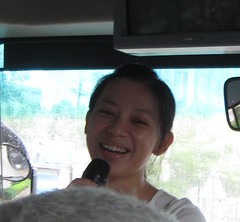
Cherry is a sunny, cheerful girl but she talks a mile a minute and peppers her spiel with lame canned jokes. I must rethink the teaching style I use for my computer classes... The views of glorious Guilin more than compensated however! The main industry here is tourism, so it's not very polluted, and the scenery - even through bus windows - is lovely.
Our optional tour today includes a visit to the Guilin Tea Institute, really a tea plantation, and lunch at a tea restaurant. This was one of the best of the optional tours - interesting and fun. First off, the scenery is really gorgeous, even in the light mist, which just made it look more romantic:
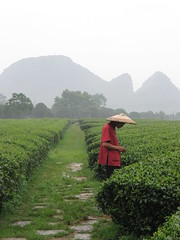
The landscape around here is something called "karst", which results from layers of soluble rock like limestone being dissolved over long, long periods of time. The Carlsbad Caverns in the USA are karst caves. This part of China ended up with a lot of flattish land with these startling and abrupt crags or mini-mountains sticking out of it - harder rocks that didn't get dissolved. So just looking around is a feast for the eyes.
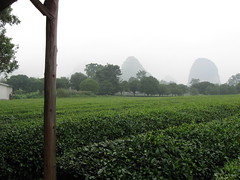
The first thing they did when we got there was give us coolie hats:
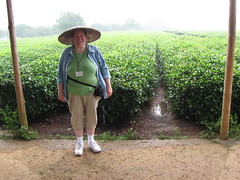
We all looked cute as buttons, and they kept the rain off. Then "Kevin" told us a whole bunch of stuff about tea:
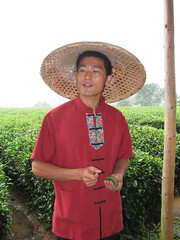
According to my now encyclopedic knowledge, the differences between types of tea come not from the tea bush itself but from a) what type of leaf is picked, and b) how the leaves are treated after picking.
They class tea into six types and only pick leaves for one type of tea on a given day. White tea, which used to be reserved for the emperor, comes from the "needle", which is the tenderest tiny baby leaf that grows from the tip of a stem and is not unfurled yet. For the best grade of green tea, they pick stem tips containing the needle plus one tender leaf; second grade green tea includes the needle and two tender leaves, and so on. Kevin never said the word "leaf" without prefacing it with "tender". None of these teas will be fermented.
Next in delicacy comes oolong tea, which is "semifermented". For oolong, they pick leaves that are a little bigger, up to two inches long; our familiar black tea, which is fermented, uses leaves up to maybe three inches long. Kevin asked what you could make with the rest of the (big, tough) leaves? I said, "Lipton!" I was right: the 'junk leaves' are fermented and powdered for tea bags.
We were then given a chance to pick tea - today is a First Quality Green Tea day.
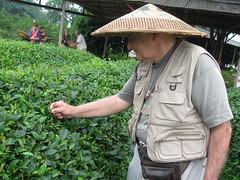
Notice how Daddy is oh-so-carefully selecting only the needle and one tender leaf? We spread throughout the field and picked rapidly (when we weren't taking pictures)
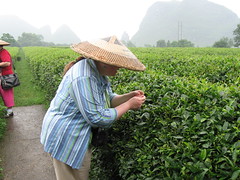
for about ten minutes.

Only afterwards did they tell us we were competing for prizes - the top tea picker got a pair of straw sandals. They wouldn't have fit me anyway...
After our shift as pickers, we went into a pretty little pavilion
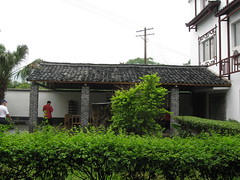
where Kevin and a "tea girl" showed us how they process green tea. It is air dried - withered - and then toasted in a 450 degree metal pan
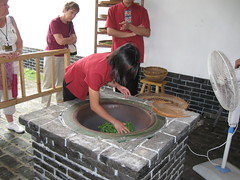
to kill the fermentation enzymes. Then the girl gathers the leaves into a ball and rolls and mushes them for half an hour until no more oil is generated:
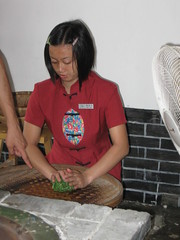
That's about it for the green tea!
Our next stop was a blessedly air-conditioned room where we will see a short version of a tea ceremony and taste some of the teas produced here. Well, the room was cool until they started boiling all that water! I keep remembering how close we are to Vietnam - only about 200 miles southeast of here. By the way, most of the population here are from the Drong, the Miao or several other ethnic minority groups.
We lined the walls, sitting on stumps at rustic log tables,
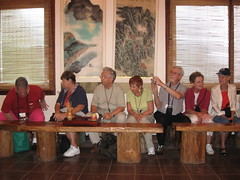
with Kevin presiding from the front:
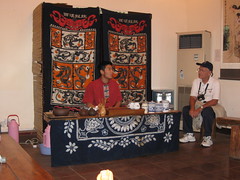
First he made us "High Mountain Yellow Tea" which is grown, as the name would imply, at a higher altitude on the slopes. It's a green tea, but toasted longer which gives it a lovely golden yellow color when brewed; Kevin tells us it's naturally caffeine-free. The dry leaves had a lovely scent; the brewed tea had a mild pleasant odor and tasted okay.
Whenever Kevin made a pot of tea, he always washed the leaves first, pouring in boiling water then pouring it off right away. We also learned you need to brew unfermented teas in glass or glazed porcelain pots but fermented tea should be brewed in porous clay pots, one for each kind of tea. He showed us the proper way to hold the tiny two-tablespoon sized teacups: men hold them in the right hand with the left shielding it and women make an elaborate and delicate shape with their hands that looks like when you're making bird shadow-pictures on the wall. I couldn't take any pictures since my hands were busy! Both sexes are supposed to drink the cup in no more than one or two sips.
Next we tried osmanthus tea, which is imbued with the fragrance of the osmanthus (the flower of the local "state tree") by being packed in racks with alternating baskets of tea and flowers. After a week or so the tea has absorbed the fragrance and they throw the flowers away. Since I don't like floral scents and tastes that well, I didn't love this one.
Third, Kevin made us a pot of "Liu Bao" or "Six Treasure" Compressed Tea. This tea comes in 250 gram bricks, and keeps for up to 40 years; the block kind of smells like scented tobacco. You chop off a few grams, wash it as always, and brew it in a clay pot. It's a mixture of several kinds of black teas, smoked with applewood and fruit smoke. It brews up way darker than ordinary black tea, and is almost thick. Its flavor is wonderful and indescribable. Dark, rich, complex and with a lingering sweet aftertaste in the mouth and throat. They say it's good for teachers and guides because it soothes the throat from all that talking. You don't sugar any of these teas, but this one sure doesn't need it.
Our final tasting experience was Ginseng Oolong tea. It, too, has an intense dark flavor with a slight bitter ginseng taste and a sweet aftertaste, and it's also supposed to be good for your throat. Its most marvelous property is to promote weight loss! All it takes is four cups a day.
I was shocked! Shocked! to find that our tour of the tea plantation finished up at a shop, though I was actually delighted to be able to buy some of the teas. I also learned why the oolong ginseng tea promotes weight loss: if you buy enough of it to drink four cups a day, you won't be able to afford to buy food!
If you spent more than 300 yuan in their shop they give you a free mini-teapot; I have two. That's just as well, because I bought two kinds of tea, the Ginseng Oolong and the Liu Bao, and I'll be able to use one pot for each kind. Since you can steep the ginseng tea at least three times, and the Liu Bao five or six times, they're not such a bad value. That's my story, anyway.
No, to tell the truth I was in the grip of purchasing madness. Dad only barely dissuaded me from buying 740 yuan worth of Liu Bao - a 500 gram block. It turns out they have international ordering, so if I get really hooked I can have more shipped over to the States. They also had a cake of 40-year old compressed tea

worth, if I understood correctly, about $20,000 dollars.

No comments:
Post a Comment